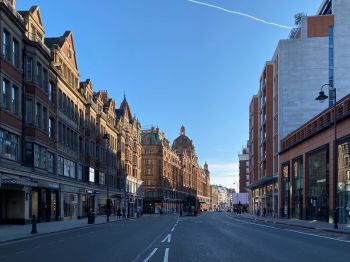
Photo by John Cameron on Unsplash
The reproduction number, or R value, for COVID-19 in the United Kingdom was below the threshold of one in May but was sufficiently high that, even if social behaviour and control interventions remained unchanged, the epidemic in the United Kingdom was likely to continue for months.
The findings come in the latest report from the WHO Collaborating Centre for Infectious Disease Modelling within the MRC Centre for Global Infectious Disease Analysis, Jameel Institute (J-IDEA), and Department of Mathematics, Imperial College London in a collaboration with the University of Sussex.
The reproduction number indicates the average number of people one infected individual will infect.
If social behaviour and control interventions had remained unchanged from 10 May, the modelling predicts that the epidemic is likely to continue for months.
Mobility - the extent to which people move beyond the home - represents an important proxy measure of contact, which influences transmissibility, especially for respiratory diseases such as COVID-19. The new report says that keeping mobility to between 57.3 and 65.9 percent below pre-lockdown levels in the United Kingdom should keep the reproduction number below one (as of 10 May, mobility was reduced by as much as 65.9%).
They also indicate that any increase in mobility above this would result in a rapid reversion to exponential growth - unless there were other changes, for example increased contract tracing.
Efforts to control COVID-19 have resulted in dramatic changes to mobility at an unprecedented global scale, for example through social distancing interventions. This report uses Apple data measures for driving, walking and transit mobility, and Google data measures for transit stations, workspaces and retail and recreation to describe change in mobility.
It found that mobility was a very good predictor of transmissibility, with over 80% of the variation in transmissibility being explained by variation in mobility. As of 10 May, mobility had been sufficiently reduced in France, Spain and the United Kingdom to keep R below one. However increased mobility restrictions, or alternative control measures, were still warranted for the majority of countries.
The researchers found encouraging early evidence of a recent decoupling of the relationship between transmission and mobility in 10 countries, suggesting alternative control strategies are being implemented and effective, a key indicator of successful easing of social distancing restrictions.
Since the emergence of the new coronavirus (COVID-19) in December 2019, the Imperial College COVID-19 Response Team has adopted a policy of immediately sharing research findings on the developing pandemic.
The report says easing social-distancing restrictions should be considered very carefully, as small increases in contact rates are likely to risk resurgence even where R has been reduced to below one.
Overall, strong population-wide social-distancing measures are effective to control COVID-19; gradual easing of restrictions must be accompanied by alternative interventions, such as efficient contact-tracing, to ensure control.
The current report examines mobility and transmissibility for 53 countries with sustained SARS-CoV-2 transmission. The threshold in mobility reduction required to bring R below 1 varied between countries; for half of the country considered, a reduction in mobility of 68.0% (Apple) and 58.6% (Google) was estimated to be sufficient to bring the reproduction number below one.
The researchers estimate that in the United Kingdom, a reduction of 65.9% (95% CrI: 62.7-69.3%) of Apple mobility and 57.3% (95% CrI: 54.0-61.1%) of Google mobility would be sufficient to reduce the reproduction number below one. On 10 May, the reduction in Apple mobility was 69.8% and for Google data this was 65.9%.
Dr Pierre Nouvellet, Reader In Evolution, Behaviour And Ecology at the University of Sussex and Visiting Reader at Imperial College London, said: "During this pandemic, the level of mobility reduction observed across the world has been unprecedented. This analysis provides very strong evidence of the benefit of population-wide mobility restriction to control such a pandemic.
"Only few countries have succeeded in reducing mobility enough to ensure an R below 1. In most countries, mobility reductions are still not high enough to control the epidemic without additional control measures. Many countries shows a recent gradual increase in mobility. Our analysis clearly demonstrates that even when under control, easing of social-distancing must be accompanied by strong alternative control measures to avoid resurgence."
Dr Sangeeta Bhatia, of Imperial College London, said: "The unprecedented reduction in mobility has played a crucial role in controlling the spread of COVID-19.
"Here we analyse the relation between transmission patterns of COVID-19 and the changes in mobility trends in various countries as reported by Google and Apple. We find that in some countries, the relation between reduction in mobility and transmission has dampened.
"This suggests that alternative control measures coupled with easing of social distancing restrictions can potentially keep the spread of COVID-19 in check."






